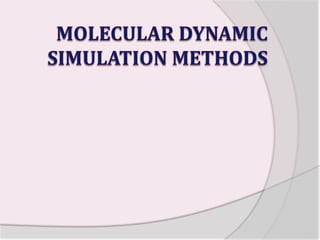
MOLECULAR SIMULATION TECHNIQUES
- 1. MOLECULAR DYNAMIC SIMULATION METHODS
- 4. Simple models Hard sphere potential Square well potential
- 5. MOLECULAR DYNAMICS USING SIMPLE METHODS The steps involved in the hard-sphere calculation as follows: Identify the next pair of spheres to collide and calculate when the collision will occur. Calculate the positions of all the spheres at the collision time. Determine the new velocities of the two colliding spheres after the collision. Repeat from 1 until finished. The new velocities of the colliding spheres are calculated by applying the principle conservation of linear momentum.
- 6. MOLECULAR DYNAMICS WITH CONTINUOUS POTENTIALS First MD with continuous potentials done in 1964 (simulation of argon by Rahman). Finite difference method: the integration is broken down into many small stages, each separated in time by a fixed time dt.
- 7. Verlet algorithm The most widely used method in molecular dynamics programs is the Verlet algorithm. It uses the positions and accelerations at time t, and the positions from the previous step, r(t-δt) to calculate new positions at t+δt, r(t+δt). Relations between positions and velocities at those two moments in time can be written as: Those two relations can be added to give: The velocities do not explicitly appear in the Verlet algorithm. They can be calculated in several ways. A very simple approach is to divide the difference in positions at times t+δt and t-δt by 2δt, i.e. Another approach calculates velocities at the half step : Practical application of this algorithm is straightforward and memory requirements are modest, only positions at two time steps have to be recorded r(t), r(t-δt), and the acceleration a(t). The only drawback is that the new position r(t + δt) is obtained by adding small term δ2ta(t) to the difference of two much larger terms 2r(t) and r(t-δt), which requires high precision for r in the numerical calculation.
- 8. Verlet algorithm The leap-frog method is the variation of Verlet algorithm. It uses the following relations: The name of this method comes from its nature, i.e., velocities make ‘leap-frog’ jumps over the positions to give their values at
- 9. Verlet algorithm The velocity Verlet algorithm gives positions, velocities and accelerations at the same time and does not compromise precision:
- 10. Verlet algorithm Beeman Algorithm Better velocities, better energy conservation More expensive to calculate
- 11. General Predictor-Corrector Algorithms Predict the position x(t+dt) and velocity v(t+dt) at the end of the next step. Evaluate the forces at t+dt using the predicted position. Correct the predictions using some combination of the predicted and previous values of position and velocity.
- 12. Gear’s Predictor-Corrector methods Predict ac(t+dt) from the Taylor expansion at the starting point Begin with a simple prediction, as in any of the previous methods Initially step to r(t+dt), v (t+dt), a(t+dt),b(t+dt) at that point. The difference between the a(t+dt) and the predicted ac(t+dt): Estimates the error in the initial step, which is used to correct:
- 13. Predictor-corrector algorithms 1. Predictor: From the positions and their time derivatives up to a certain order q, all known at time t, one ``predicts'' the same quantities at time by means of a Taylor expansion. Among these quantities are, of course, accelerations . 2. Force evaluation: The force is computed taking the gradient of the potential at the predicted positions. The resulting acceleration will be in general different from the ``predicted acceleration''. The difference between the two constitutes an ``error signal''. 3. Corrector: This error signal is used to ``correct'' positions and their derivatives. All the corrections are proportional to the error signal, the coefficient of proportionality being a ``magic number'' determined to maximize the stability of the algorithm.
- 14. Evaluate integration methods Fast, minimal memory, easy to program Calculation of force is time consuming Conservation of energy and momentum Time-reversible Long time step can be used
- 15. Which algorithm is appropriate Cost effective Energy conservation Root-mean-square fluctuation Total, 0.02 kcal/mol KE and PE, 5 kcal/mol
- 16. Choosing the time step Too small: covering small conformation space Too large: instability Suggested time steps Translation, 10 fs Flexible molecules and rigid bonds, 2fs Flexible molecules and bonds, 1fs
- 17. Multiple time step dynamics Reversible reference system propagation algorithm (r-RESPA) Forces within a system classified into a number of groups according to how rapidly the force changes Each group has its own time step, while maintaining accuracy and numerical stability
- 18. Molecular dynamics setup Initial configuration Initial velocities (Maxwell-Boltzmann) Force field Cutoff: doesn’t save time by itself. But can combine with neighbor list and speed-up the simulation
- 19. Running molecular dynamics Equilibration Special care is needed for inhomogeneous system Calculating the temperature Nc is the number of constraints, so 3N – Nc is the total number of degrees of freedom Boundary conditions No boundary Periodic boundary condition Non-periodic: reaction zone, harmonic constraint boundary atoms
- 20. Constraint dynamics High frequency modes takes all the computer time Low frequency modes correspond to conformational changes Constraint: system is forced to satisfy certain conditions SHAKE: constraint the bond vibration
- 21. REFERENCE Molecular Modelling - Andrew R. Leach (Principles and Applications) http:/docjax.com/molecular dynamic simulation methods/ http:/google.com/molecular dynamics/ simulation simple methods/ http:/google.com/molecular dynamic simulation with continuous potential/
- 22. THANQ